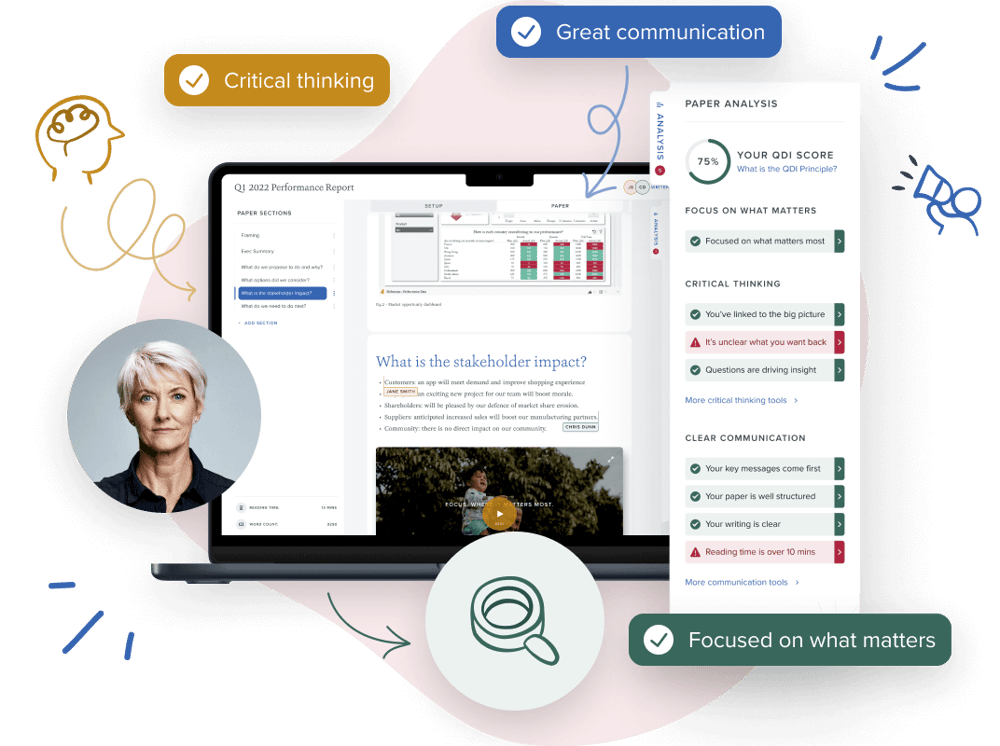The QDI Principle
Drive business pace & performance with this methodology for critical thinking.

What is Question-Driven Insight?
The Question-Driven Insight (QDI) Principle is a methodology designed to build the skills that power the world’s most enduringly successful organizations. These skills are critical thinking, great communication, and focus.
When we think critically, we bring breakthrough insights and ideas to light. When we communicate impactfully, we spur others to action. And when we focus on our most important problems and opportunities, we effect change.
When we do all this at every level of the organization, we harness our collective intelligence to go further and move faster.

Why use the QDI Principle?
By applying the QDI Principle to the everyday habits your business is run on — like business reviews and board meetings — you’ll unleash your team’s collective intelligence by helping them think critically, communicate effectively, and focus on the right priorities.
Through the QDI Principle, every meeting or report becomes an opportunity to deliver actionable insights that drive action in your business.

See how Beazley used QDI to unlock strategic conversation
Anyone who’s involved in the everyday activities you run your business on, from board meetings to routine management reporting, can use the QDI Principle.
It can be adopted by individuals and teams, but you’ll notice its impact the most when it’s embedded across your organization.
“We’ve adopted the QDI Principle to help us think through the questions we should be answering and the storytelling behind our reports.”
~ Rachael Turk, Beazley (FTSE 100 insurer)
How does the QDI Principle work?
When writing a board paper or management report, follow these nine tenets to supercharge it with sharp thinking and transform insight into action. Select a tenet to find out more.
Asking the right questions will get you to the crux of what matters at a faster pace.
Look for the questions that are difficult to answer, and likely to reveal uncomfortable truths. These questions are the ones you need to tackle head-on, and the ones that will add the most value to your thinking.
Ask yourself:
Have I answered the difficult questions? Am I avoiding any uncomfortable truths?
Review the questions you plan to tackle to identify gaps in your thinking, then fill those gaps.
Your questions should have a sense of completeness to them, either as a flow of logic (What are the options? What do I suggest, and why? What do we need to do next?) or as parts of a whole (What went well? What went badly?).
The time invested in filling gaps will deliver deeper critical thinking.
Ask yourself:
Do my questions cover all the angles? Have I considered all of my stakeholders, the risks and the opportunities, and the internal and external contexts?
Challenge yourself to draw meaning from the information you have by asking “so what?”, and “what should I do differently as a result?”
Two simple questions will draw out this meaning and fuel your critical thinking.
Ask yourself:
Have I pulled out the “So what?” from the information I have presented? And is it actionable insight that will have an impact?
Don’t hide behind the passive voice, like many business writers do. To the reader, this comes across as a lack of confidence and accountability.
When you own the message (whether it’s good news or bad), and share what you think and feel with the reader, you display the leadership qualities everyone is looking for.
Ask yourself:
Is this my voice, and am I owning it? Can I build my readers’ trust and get more value back by sharing more candid information?
Much like a diamond, writing shines more when it’s cut.
To catch and keep your reader’s attention, get rid of long sentences, technical jargon, and complex words.
Organize your thinking under no more than 5 headings; the human brain (even the CEO’s) has to work too hard to cope with more.
Ask yourself:
Have I used simple words and short sentences? Have I explained the acronyms and jargon I’ve used? Do I have 5 or fewer main headings?
In the military, where communication is critical, they call this the “BLUF”: putting the Bottom Line Up Front.
The BLUF principle also applies to a time-poor business audience. Tear up the essay-writing rule book you were given at school, and start with the conclusion before you share your workings.
Ask yourself:
Are my key messages clear to the reader? Have I summarized them on page 1 of my report?
The multiplier effect is powerful when everyone pulls in the same direction. But it's easier said than done.
It’s important to keep asking 'why' you are doing what you are doing, to ensure it serves the overall purpose and vision of the organization.
Ask yourself:
How do my team and I help deliver the company's vision? How are we performing in service of this? How will my proposals support it?
Management expert Stephen Covey talks about the ‘activity trap’ - climbing the ladder of success only to discover it’s been leaning against the wrong wall.
By keeping your strategy and plans front of mind and regularly questioning the link between your intentions and your actions, you'll avoid wasted work.
Ask yourself...
How do our plans and proposals support the overall strategy of the organization? And how have we performed against it?
What makes the culture and values of your organization worth more than just snappy slogans? This happens when you judge your plans and performance against them, too. So give life to them in your reports.
Ask yourself:
How well is my team performing against not just our commercial goals but our culture and values as well? How do our plans and proposals impact the style of organization we’re trying to build?

Should I be using the QDI Principle?
The QDI Principle and the community that uses it are underpinned and united by three core beliefs:
- Our organizations have immense brainpower and we win when we tap into everyone's insights and ideas.
- When we have the full picture, we can effectively make decisions that benefit us and society.
- We need to move faster to navigate our challenges and maximize our opportunities.

How to embed the QDI Principle at scale
We know that new skills don’t just happen overnight. You need support to create long-lasting change and embed new behaviors in your organization.
That’s why we’ve created Lucia, an AI-powered software platform to help you encourage critical thinking, great communication, and clear focus at every level of your business.
Learn about our reporting software
A comprehensive guide to Question-Driven Insight
Thousands of businesses have used the QDI Principle to unleash their collective intelligence and enhance their board and management reporting processes.
Find out how you can do the same in Collective Intelligence: How to build a business that’s smarter than you, an essential guide authored by Jennifer Sundberg and Pippa Begg. In this book, Board Intelligence’s co-CEOs draw on their work with the world’s most meticulous leaders and share the principles that have helped the most successful businesses stay winners, decade after decade.
Read the bookApplying the QDI Principle
Practical resources to help you apply the Question-Driven Insight Principle


